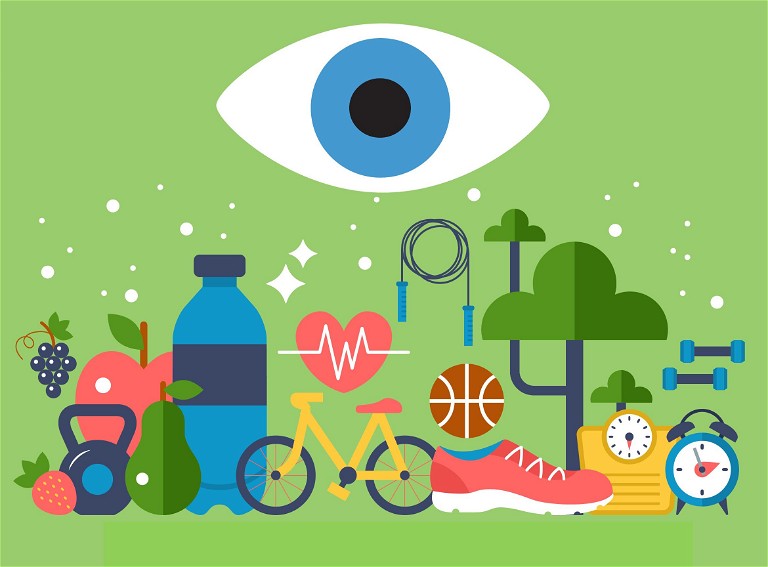The GLAUCOMA ISSUE
mifeature
Protecting Retinal Ganglion Cells
with Lifestyle Interventions

Worldwide, the number of patients suffering from glaucoma has likely already exceeded the estimated 76 million for the year 2020, and this number is expected to increase to almost 112 million people by 2040 as our populations age.1 Drs Katharina Bell and Vicki Chrysostomou, and Professor Jonathan Crowston, argue that research needs to focus on earlier interventions that include diet, exercise, and neuroprotective pharmacology.
WRITERS Dr Katharina C. Bell, Dr Vicki Chrysostomou, and Professor Jonathan G. Crowston
Current glaucoma management is still based on indirectly protecting retinal ganglion cells (RGC) by lowering intraocular pressure (IOP). Although this arrests disease progression in many patients, a proportion continue to lose vision. Visual loss additionally increases the risk of falls and car accidents,2 and can lead to anxiety and social isolation.
An Australian survey conducted by Vision 2020 revealed that Australians fear vision loss more than losing any other sense, losing a limb, or suffering a heart attack .3 It is, therefore, not uncommon for patients to ask whether they can take additional measures to help preserve their vision.
Next to elevated IOP, increasing age is a second major risk factor for glaucoma. Until recently, ageing has been considered nonmodifiable, however advances in the field of geroscience have shown that biological ageing and the associated risk of age-related diseases can be modified.
Our research has therefore focussed on determining why advancing age increases RGC vulnerability to IOP elevation with a view to finding lifestyle and pharmacologic inter ventions that reverse this.
IMPACT OF ADVANCED AGEING AND IOP INJURY ON RGC FUNCTION
We have conducted extensive studies in the mouse eye to demonstrate that RGCs become less resilient to IOP elevation with advancing age.
Using electroretinography (ERG) to measure RGC function, we have shown that shortterm IOP elevation consistently leads to a 50% reduction in the pSTR (the RGC-derived scotopic threshold response) in young (threemonth-old), middle-aged (12-month-old), and old (24-month-old) mice. However, whereas young mice recover full retinal ganglion function (pSTR) within seven days after the injury, middle-aged mice need 28 days to recover function, and RGCs of the oldest mice fail to recover function at all.
This age-related loss in RGC resilience becomes even more apparent when mice are subjected to a second short-term IOP elevation. In these experiments we subjected three-month and 12-month-old mice to receive a second IOP challenge once the mice had recovered RGC after the first injury. Three-month-old mice were again fully able to recover RGC function, although this was slightly slower than after the first injury. In contrast, middle-aged mice did not recover RGC function at all with the second IOP challenge, leading to widespread neurodegeneration with loss of 40% of RGCs, and significant disruption to axon transport and axon structural integrity.4
This acute IOP challenge model in the mouse eye has enabled us to investigate whether various lifestyle interventions, that are known to influence the ageing process, could restore age-related loss of neurorecovery and improve RGC resilience in the mouse eye.
“ Until recently, ageing has been considered nonmodifiable ”
DIETARY INTERVENTIONS
Dietary interventions, such as calorie restriction or intermittent fasting, were initial candidate inter ventions as they have been shown to increase the turnover and recycling of damaged organelles such as mitochondria and other cellular components in tissues. This process is called autophagy; the specific clearance of damaged mitochondria is termed mitophagy. We know that bulk autophagy decreases with age in the retina and that defective autophagy in genetically modified mice increases retinal ganglion cell loss following mechanical injury in optic nerve crush experiments.5 Middle-aged mice subjected to six months of alternate day fasting did show some improvement in neurorecovery. Measuring the pSTR seven days after an acute IOP challenge, George Kong, then a PhD student in the Crowston lab, demonstrated that intermittent fasting for six months significantly improved RGC recovery when compared to littermate control animals provided with a steady supply of food (ad libitum fed).6 This study provided the first evidence that long-term intermittent fasting could reverse the negative effect of ageing on RGC resilience.
In more recent experiments, we have investigated whether shorter-term fasting initiated after an IOP challenge can confer similar levels of protection. Even though these shorter interventions increased autophagy and mitophagy markers in the retina they did not restore functional recovery in the same way as long-term intermittent fasting (manuscript in preparation).
EXERCISE AND GLAUCOMA
Exercise has long been known to boost healthy longevity across multiple organ systems. Research in the field of dementia has shown the benefits of physical activity in the central nervous system as patients with early cognitive decline had a significant improvement in cognitive capacity after following a weekly exercise program of three 30-minute walks over and above their habitual exercise.7 In line with this, the World Health Organization has recently incorporated a strong recommendation in its dementia guidelines for patients to maintain regular physical activity.
There is accumulating evidence that exercise can also protect from glaucoma. A study analysing data from the Prospective National Runners Health Study, which reported incident (self-reported) glaucoma among 29,854 runners followed for 7.7 years, found a dose-related response in that runners who ran further weekly distances and recorded faster 10 km times had significantly lower incident glaucoma.8
We have also studied the effect of exercise on RGC resilience to IOP elevation in the mouse eye. Middle-aged mice provided with running wheels in their cages, or made to swim for one hour a day for one week after an IOP challenge, demonstrated significantly better neurorecovery than non-exercised agematched mice. This protection is very robust to the extent that exercised 12-month-old mice recovered just as well as three-monthold mice.9 Interestingly, protection was apparent not only when mice were exercised before and after IOP injury, but also when exercise was started 24-hours post injury.10
We subsequently performed mechanistic studies that showed that the exercisemediated protection was critically dependent on brain-derived neurotrophic factor (BDNF) signalling. Current work is exploring this further to determine the source of BDNF and how this is regulated in exercised animals.
A recent review paper by Kumar and Ou concluded that clinicians should consider recommending aerobic exercise to their glaucoma patients.11 Randomised clinical exercise inter vention trials (RCTs) are, however, still necessary to determine whether exercise – and what forms of exercise – might be beneficial for RGC protection in glaucoma.
“ Middle-aged mice provided with running wheels in their cages… demonstrated significantly better neurorecovery than non-exercised agematched mice ”
NICOTINAMIDE AND GLAUCOMA
Exercise may not be feasible in all patients with glaucoma. Individuals with visual field loss from glaucoma perform fewer daily steps and less daily minutes of vigorous exercise.8 Pharmacologic interventions that boost RGC resilience are thus also being actively sought.
Currently, several prospective randomised controlled clinical neuroprotection trials have been initiated in Australia, Singapore, Sweden, the United Kingdom, Hong Kong, and the United States to determine whether nicotinamide (NAM) and related molecules can slow glaucoma progression. Initiation of these intervention studies was sparked by substantial pre-clinical evidence in experimental models that showed substantial neuroprotection in different models of optic nerve injury in rats and mice. Two initial pilot RCTs that randomised patients to nicotinamide alone or nicotinamide in combination with pyruvate showed shortterm improvement of inner retinal function in ERG and/or visual field measurements.12,13 The current studies will determine whether nicotinamide supplementation also slows longer-term progression in glaucoma.
REFOCUSSING FUTURE RESEARCH
Currently, clinicians start thinking about alternative or adjunct neuroprotective measures at the point when glaucoma damage is advanced and likely having a noticeable impact on the everyday life of the patient.
However, effective neuroprotective therapy stands to also benefit patients at much earlier stages of the disease.14,15 It is therefore important, when designing our neuroprotection clinical trials, that we also consider their utility for early-stage glaucoma patients.

Dr Katharina C. Bell MD PhD is an ophthalmologist and clinician scientist. She is a Senior Lecturer and Clinical Lead Ophthalmology at the NHMRC Clinical Trials Centre at the University of Sydney. She also holds an adjunct position at DUKE-NUS Singapore/Singapore Eye Research Institute.
Dr Vicki Chrysostomou PhD is a Senior Research Fellow at Duke NUS Medical School in Singapore. She was previously a Postdoctoral Research Fellow at the Glaucoma Research Unit at the Centre for Eye Research Australia (CERA).
Professor Jonathan G. Crowston MBBS FRCOphth FRANZCO PhD is a clinician scientist and Professor of Ophthalmology at the University of Sydney. He also holds an adjunct Professor position at Duke-NUS Medical School, Singapore.
References
1. Tham, Y.C., Li, X., Cheng, C.Y. et al., Global prevalence of glaucoma and projections of glaucoma burden through 2040: a systematic review and meta-analysis. Ophthalmology. 2014;121(11):2081–90.
2. Haymes, S.A., Leblanc, R.P., Chauhan, B.C., et al., Risk of falls and motor vehicle collisions in glaucoma. Invest Ophthalmol Vis Sci. 2007;48(3):1149–55.
3. Vision2020 Australia, Aussies Fear Going Blind But Still Take Sight For Granted: Study (news release, issued 10 October 2013), available at: vision2020australia.org.au/media/2013-10-10/aussies-fear-going-blind-but-still-takesight-for-granted-study/ [accessed 9 Jan 2024].
4. Chrysostomou, V., Bell, K.C., Ng, S.W., et al., A new model of axon degeneration in the mouse optic nerve using repeat intraocular pressure challenge. Exp Eye Res. 2023;238:109722.
5. Bell, K., Rosignol, I., Sierra-Filardi, E., et al., Age related retinal ganglion cell susceptibility in context of autophagy deficiency. Cell Death Discov. 2020;6:21.
6. Kong, Y.X., van Bergen, N., Bui, B.V., Chrysostomou, V., et al., Impact of aging and diet restriction on retinal function during and after acute intraocular pressure injury. Neurobiol Aging. 2012;33(6):1126 e15-25.
7. Lautenschlager, N.T., Cox, K.L., Flicker, L., et al., Effect of physical activity on cognitive function in older adults at risk for Alzheimer disease: a randomized trial. JAMA. 2008;300(9):1027–37.
8. Williams, P.T. Relationship of incident glaucoma versus physical activity and fitness in male runners. Med Sci Sports Exerc. 2009;41(8):1566–72.
9. Chrysostomou, V., Kezic, J.M., Trounce, I.A., Crowston, J.G., Forced exercise protects the aged optic nerve against intraocular pressure injury. Neurobiol Aging. 2014;35(7):1722–5.
10. Chrysostomou, V., Galic, S., Crowston, J.G., et al., Exercise reverses age-related vulnerability of the retina to injury by preventing complement-mediated synapse elimination via a BDNF-dependent pathway. Aging Cell. 2016;15(6):1082–91.
11. Kumar, A., Ou, Y., From bench to behaviour: The role of lifestyle factors on intraocular pressure, neuroprotection, and disease progression in glaucoma. Clin Exp Ophthalmol. 2023;51(4):380–94.
12. Hui, F., Tang, J., Williams, P.A., et al., Improvement in inner retinal function in glaucoma with nicotinamide (vitamin B3) supplementation: A crossover randomized clinical trial. Clin Exp Ophthalmol. 2020;48(7):903–14.
13. De Moraes, C.G., John, S.W.M., Liebmann, J.M., Nicotinamide and pyruvate for neuroenhancement in open-angle glaucoma: A phase 2 randomized clinical trial. JAMA Ophthalmol. 2022;140(1):11–8.
14. Sehi, M., Grewal, D.S., Goodkin, M.L., Greenfield. D.S., Reversal of retinal ganglion cell dysfunction after surgical reduction of intraocular pressure. Ophthalmology. 2010;117(12):2329–36.
15. Tang, J., Hui, F., Hadoux, X., et al., Short-term changes in the photopic negative response following intraocular pressure lowering in glaucoma. Invest Ophthalmol Vis Sci. 2020;61(10):16.
“ …effective neuroprotec tive therapy stands to also benefit patients at much earlier stages of the disease ”